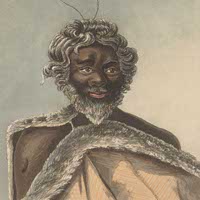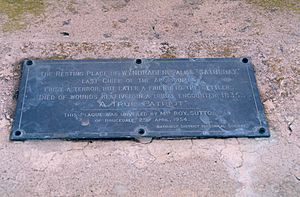Windradyne facts for kids
Quick facts for kids
Windradyne
|
|
|---|---|

A Wiradjuri warrior, thought to be Windradyne
|
|
| Born | c. 1800 Northern Wiradjuri nation (Central West (New South Wales))
|
| Died | 21 March 1829 (aged 29–30) |
| Cause of death | Battle injuries |
| Resting place | Brucedale Station, Peel |
| Monuments | Grave of Windradyne |
| Nationality | Wiradjuri, Australian |
| Other names | Saturday, Windrodine, Windradene |
| Occupation | Warrior |
| Years active | 1822–1829 |
| Known for | Fighting Australian settlers |
Windradyne (born around 1800 – died 21 March 1829) was an Aboriginal warrior and important leader. He belonged to the Wiradjuri nation in central-western New South Wales, Australia. British settlers also knew him as Saturday. Windradyne led his people in the Bathurst War. This was a conflict between his clan and the British settlers.
Contents
Who Was Windradyne?
We don't have a lot of information about Windradyne. Most of what we know comes from British records from his time. But we can still learn about this important leader.
Windradyne's exact birth date is not known. When he died in 1829, a newspaper called The Sydney Gazette and New South Wales Advertiser wrote about him. This article said he was probably around 30 years old. This means he was likely born around 1800. It is believed he did not have any children.
People described Windradyne as handsome and strong. He had broad shoulders and muscular arms. He had dark brown skin, thick black curly hair, and a long beard. He often wore a headband. His beard was sometimes braided into three parts.
When Windradyne met with Governor Thomas Brisbane in December 1824, a newspaper described him. It said he was "one of the finest looking natives we have seen." They noted he was strong and had a "noble looking countenance, and piercing eye." Another person said he was "a very fine figure, very muscular."
British Settlers Arrive
Conflicts between Indigenous Australians and British settlers started soon after the First Fleet arrived in 1788. At first, these fights were small and not very common. But as more British people came and spread out from Sydney, they met more Aboriginal groups. The fights became more frequent and intense. These conflicts are known as the Australian frontier wars.
For 25 years, the Blue Mountains kept settlers away from Wiradjuri land. But in 1813, explorers found a way across the mountains. They followed existing Aboriginal trails. They saw vast grasslands on the other side, which was Wiradjuri country.
In 1815, a road was built across the Blue Mountains. Soon after, Governor Lachlan Macquarie chose the spot for the town of Bathurst. This opened the area for British settlement.
First Meetings with Wiradjuri People
Early meetings between the Wiradjuri and the British were friendly. In 1813, an explorer named George Evans met two Wiradjuri women and four children. He wrote that they were scared at first. But he gave them fish and tools, and they became friendly.
Governor Macquarie also met Wiradjuri people in 1815. He said they were "very inoffensive and cleanly." His aide, Major Antill, also described them as "harmless and inoffensive." They seemed "mild and cheerful."
At this time, Windradyne would have been a teenager. We don't know for sure if he met Evans or Macquarie. But it's possible, as they were in his clan's area. British settlement was slow at first. But tensions grew as the Wiradjuri lost their traditional campsites, hunting grounds, and sacred places.
The Bathurst War Begins
Tensions on Wiradjuri land grew after British settlers arrived. Governor Macquarie had wanted slow settlement. But when Governor Thomas Brisbane took over in 1821, he wanted faster growth. Many settlers were given land, which put a strain on resources. This also strained relationships with the Wiradjuri people. Windradyne, though still a young man, became a key leader for the Aboriginal community. He resisted these changes in what became known as the Bathurst War.
Rising Conflicts
It is thought that Windradyne led his first attacks in early 1822. Some stockmen were attacked, and livestock were released or killed. More attacks on settlers and their animals were reported. These actions by the Wiradjuri made workers afraid. Some settler stations were even left empty.
In December 1823, 'Saturday' (Windradyne) was linked to the deaths of two stockmen. Settlers asked for military help. Soldiers were sent to arrest him. Windradyne faced the soldiers. It took six soldiers and a musket beating to capture him. He was sent to prison for one month. A newspaper reported that the Wiradjuri said "white men have driven away all the kangaroos and opossums, and that black men must now have beef!"
After Windradyne was released, conflicts grew worse. There were reports of violence against Wiradjuri people, including women and children. Some sources say this included members of Windradyne's family. There were also stories of settlers leaving out poisoned food.
One story tells of a settler at Kelso who offered potatoes to a group of Wiradjuri people, possibly including Windradyne. The next day, the Wiradjuri returned for more potatoes. The settler became angry. He gathered a group of people and chased the Wiradjuri. An unknown number of the Wiradjuri family group were killed. The Wiradjuri then regrouped. Windradyne told the elders he would lead the revenge, following Wiradjuri custom.
Wiradjuri warriors prepared for battle. They attacked a settler named Samuel Terry on May 24. He and six other stockmen were killed. His hut was burned, and his animals were slaughtered. This homestead was reportedly built on a bora ground, an important Wiradjuri initiation place. Other attacks followed.
Settlers also sought revenge. Armed groups attacked Wiradjuri people. But the Wiradjuri were skilled in bushcraft. They could attack by surprise and disappear into the bush. By August 1824, newspapers were worried about the colony's ability to handle the Wiradjuri.
Martial Law and Peace Efforts
Because of the ongoing conflicts, Governor Brisbane declared martial law on August 14, 1824. This gave military leaders more power. More troops were sent to Bathurst. The violence increased, and many Wiradjuri people were killed. Many victims were Wiradjuri women and children. It is thought that between a quarter and a third of the Wiradjuri in the Bathurst area died during this time.
A reward of 500 acres of land was offered for Windradyne, dead or alive. But he was never captured or betrayed. The high number of Wiradjuri deaths caused many to surrender. This helped the crisis calm down. Governor Brisbane ended martial law on December 11, 1824.
With so many losses, Windradyne gathered the Wiradjuri. They decided to meet the Governor to formally end the fighting. The Governor usually held a yearly feast for Aboriginal people in December at Parramatta. The Wiradjuri thought this would be a safe place to meet.
Windradyne led the Wiradjuri nearly 200 kilometers across the mountains to the feast on December 28, 1824. Windradyne became the center of attention. He received a formal pardon from Governor Brisbane. The Sydney Gazette reported that Windradyne wore a straw hat with the word "PEACE" on it. He also had a small branch, like an olive branch. This showed his desire for peace.
Governor Brisbane reported to his superior that Windradyne, "their great and most warlike Chieftain, has been with me to receive his pardon." Windradyne stayed in Parramatta for some time before returning to Bathurst. He did not attend the feast the next year. Later reports sometimes linked him to raids on crops, but there was little proof.
Windradyne's Death
Windradyne died in 1829. The details of his death are a bit unclear. Most reports agree he was hurt in a tribal fight near the Macquarie River. He was then taken to Bathurst Hospital.
An early newspaper report said he died in the hospital. It said he talked to his people until the end. He was then wrapped in his mantle (a type of cloak) and buried nearby with his weapons.
Later stories, passed down by the Suttor family, add more details. They said Windradyne left the hospital and returned to his people. They were camped on the Suttor's Brucedale Station, about 12 kilometers north of Bathurst. There, he died from his injuries. He was given a Wiradjuri burial at sunrise. He was buried sitting up, facing the rising sun, wrapped in his cloak with his weapons. This second story is likely more accurate. Windradyne's grave is indeed on Brucedale Station. The first story might have been less detailed to protect the Suttors or Windradyne's grave from settlers seeking revenge.
Remembering Windradyne
A Wiradjuri burial site on Brucedale Station has two graves. In 1954, the Bathurst District Historical Society marked it as Windradyne's resting place. They put up a monument, a plaque, and a stone axe-head. In 2006, the grave site was recognized as important by the state. It is called the Grave of Windradyne.
The Wiradjuri people still honor Windradyne today as a great warrior. His grave site is an important and respected place. Wiradjuri people have planted trees around the grave in a traditional diamond shape.
A suburb in Bathurst is named after Windradyne. One of the student buildings at Charles Sturt University in Wagga Wagga is also named after him.
In 2004, Windradyne was honored in the New South Wales Parliament Buildings in Sydney. He was one of two Indigenous Australians remembered there. The other was Pemulwuy, who fought against European settlement near Sydney. Two cloaks were displayed, one for each warrior. The cloak for Windradyne had an inscription. It said he "led the resistance around Bathurst for many years, gathering together the Wiradjuri tribes."
In 2008, Windradyne's story was shown in the first episode of First Australians. This was an award-winning documentary series by SBS.
See also
 In Spanish: Windradyne para niños
In Spanish: Windradyne para niños
- Jandamarra of the Bunuba nation
- Musquito a warrior of the Gai-Mariagal clan
- Pemulwuy, a warrior and resistance leader of the Bidjigal clan of the Eora people, in the area around Sydney
- Tunnerminnerwait was an Aboriginal Australian resistance fighter and Parperloihener clansman from Tasmania
- Yagan, a warrior and resistance leader of the Noongar tribe, in what is now the area around Perth, Western Australia


